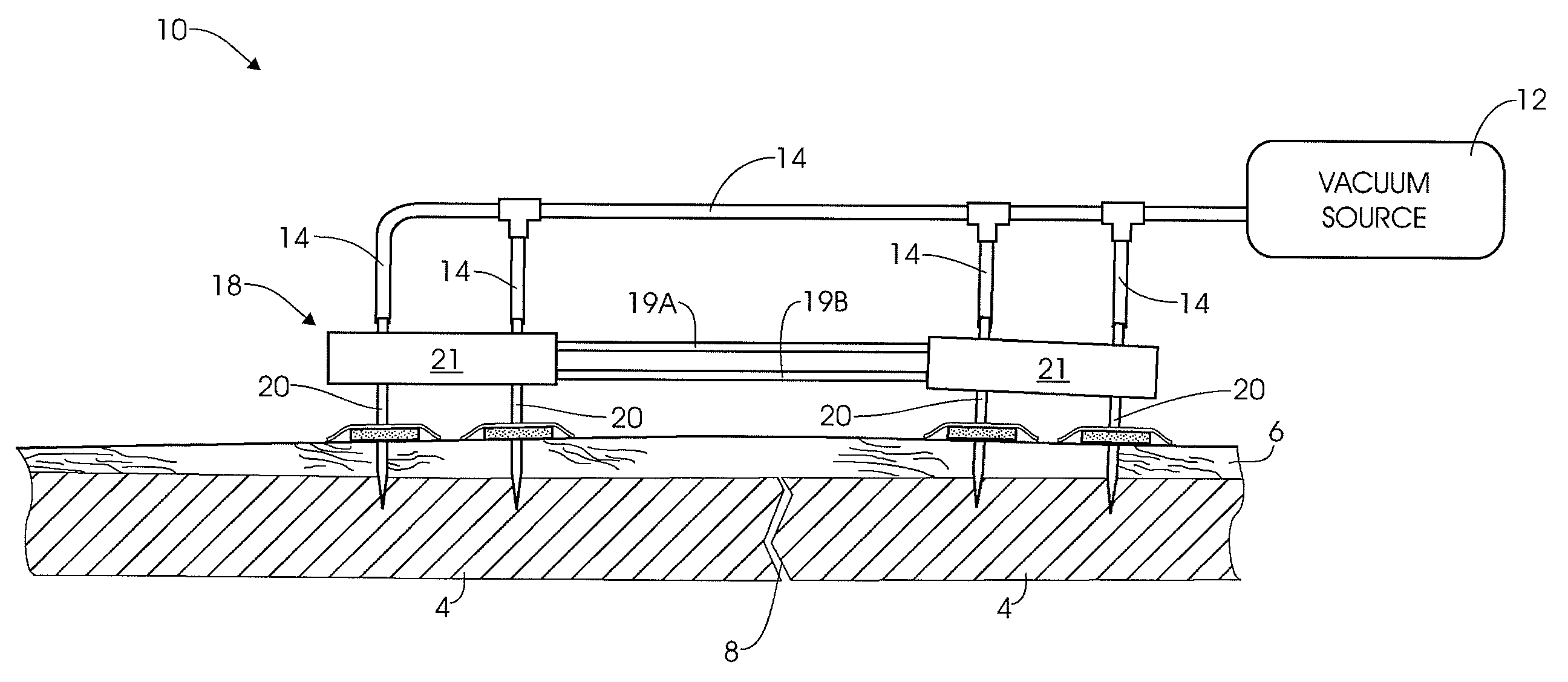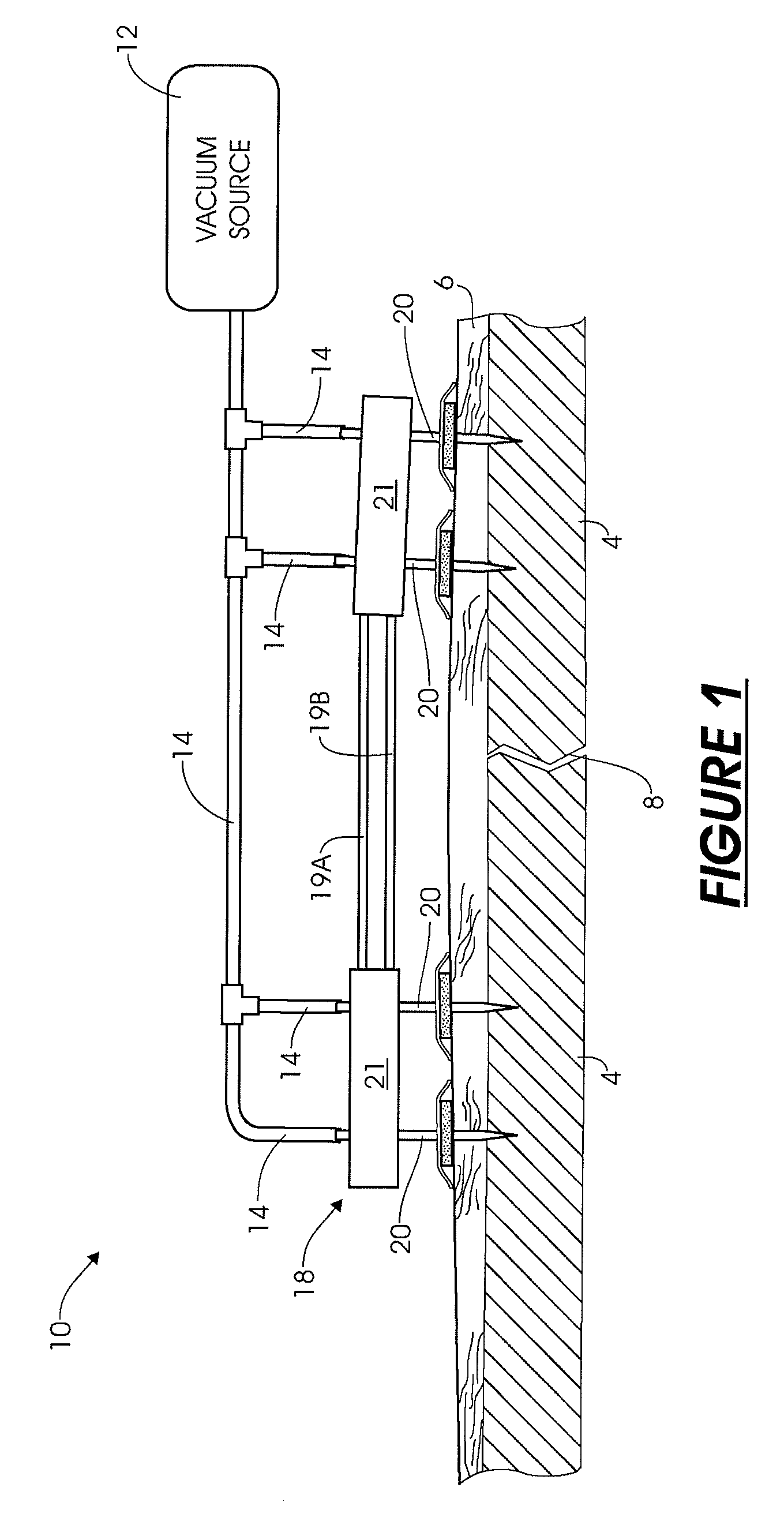External fixation assembly and method of use
a technology of fixing pins and fixing rods, applied in the field of external fixation, can solve the problems of aggravated patient's condition, infection of the pin tract in the bone, delay in patient recovery, etc., and achieve the effect of reducing pressure, reducing inflammation and infection, and reducing pressur
- Summary
- Abstract
- Description
- Claims
- Application Information
AI Technical Summary
Benefits of technology
Problems solved by technology
Method used
Image
Examples
second embodiment
[0027]Returning now to FIG. 2A, a plurality of apertures 34 may be formed through the non-threaded section 33 of the shaft 23 to form a vent section 35 along the length of the shaft. The apertures 34 extend through the wall of the shaft 23. When the vacuum pump 12 is activated, the vacuum pump draws air or gas through the apertures 34 to create negative pressure through and along the apertures. The apertures 34 may be positioned at various locations relative to the tip 27 to apply reduced pressure at specific areas within the pin tract. For example, the apertures 34 may be positioned where the pin intersects with the epidermis 5 (“skin / pin interface”), as shown in FIG. 2. In this arrangement, the apertures may form a vent section 35 at a location at and above the epidermis to supply negative pressure through a reduced-pressure distribution element or screen 50. Alternatively, the apertures 34 may be positioned where the pin intersects deeper tissue layers in the dermis 6. Apertures ...
third embodiment
[0035]Referring now more specifically to FIG. 3, a fixator pin 120 is shown. The fixator pin 120 is configured to apply reduced pressure at the bone / pin interface in a pin tract. The fixator pin 120 is substantially similar to the pins described above, having a hollow shaft 131 with a central bore 125, an insertion end 126, a threaded section 130 on the insertion end, a non-threaded section 133, and a plurality of apertures 134. The apertures 134 are formed in the threaded section 130 of the insertion end 126 as opposed to the non-threaded section 133 of the shaft. In this way, the reduced pressure is applied through bore 125 to the pin tract inside the bone 4. Referring to FIG. 4, the apertures 134 are preferably recessed in the groove formed by the thread on the threaded section at the tip 137. The groove provides additional void space around the apertures to reduce the potential for clogging caused by bone fragments that may become lodged in the apertures.
fourth embodiment
[0036]In some cases, it may be desirable to locate the vacuum port as a side port on the side of the pin, rather than at the attachment end. For example, the fixator appliance may have retainers that connect over the top of the fixator pins, covering the attachment ends of the pins and preventing connection of flexible tubing to the attachment ends. Therefore, locating the vacuum port on the side of the pin can avoid problems that occur when the attachment end is obstructed or inaccessible. In FIG. 5, a fixator pin 220 is shown in accordance with the invention. The fixator pin 220 is connected to a retainer 221 that covers the end of the fixator pin. A vacuum port 228 is formed through the side wall of the pin 220 and connects with a flexible tube 214. A cylindrical hub 229 surrounds the vacuum port 228 and projects radially outwardly from the side wall of the pin 220. The flexible tube 214 is adapted to slide over the hub 229 to connect the port 228 to a vacuum pump or other source...
PUM
 Login to View More
Login to View More Abstract
Description
Claims
Application Information
 Login to View More
Login to View More - R&D
- Intellectual Property
- Life Sciences
- Materials
- Tech Scout
- Unparalleled Data Quality
- Higher Quality Content
- 60% Fewer Hallucinations
Browse by: Latest US Patents, China's latest patents, Technical Efficacy Thesaurus, Application Domain, Technology Topic, Popular Technical Reports.
© 2025 PatSnap. All rights reserved.Legal|Privacy policy|Modern Slavery Act Transparency Statement|Sitemap|About US| Contact US: help@patsnap.com



